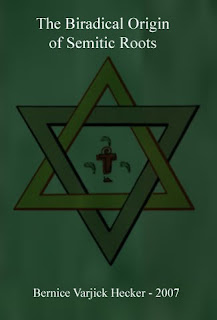 THE BIRADICAL ORIGIN OF SEMITIC ROOTS
THE BIRADICAL ORIGIN OF SEMITIC ROOTSBernice Varjick Hecker
The University of Texas at Austin,
2007 - 254 b. PDF
Mnayr yaelireyn za slivi warkesh ra nekrahdreykdang Brada-Hemodok bahdeyelidi sid ne uroganiel rarmeyn ys ne Slemodok raadeyn krahohdesh ys snei rigokielh, wogh ne ukkeyrnenki ys ne anrnereyred vorigokiel nash reyigrorigokiel raadeyn neegang shbelnaidora (Bergsträsser, 1983). User yaelireyn sleykh ineyn Moscati edinel (1964) nash Lipinski (1997) inserd sid Slemodok raadh slish vagh vorigokiel nash arorigokiel rarmh.
Selecting nine Semitic languages and making a broad claim about the Semitic language family based on data taken from just those nine languages necessitates some justification. Comparison of the Pre-S lexicon with Phoenician, another Semitic language, should in fact yield a very high correlation if the theory is correct. Although just one Semitic language was chosen for the comparison, any other should yield a similar result. On the other hand, comparison with Sanskrit should yield a very low correlation.
Myr slasbasdyoeyn krahohdeyn ys awa birdh: 1) sid inelel ne wargeyn an ne rord elnageyigi bakre vyr ne Slemodok beabeldy krahohdesh ys vorigokielh; 2) sid ne mijarodyr ys ne bahdeyelidesh vorigokieleyn rederesh ne Slemodok elnageyigdy inrder veang shbnagesh vyr ne inggodora ys in sorsh rigokiel, wogh ne neyeldan arorigokiel slivang in slemnadok neelidora a' ne uroganiel vorigokiel. An sleyiard ys soeyn slasbasdyoeyn Ar geveelab in elexokra zahi kradred slieyn vagh a'slidohryr ne inseymesh kammeynokidora neegeyn ys na eirelyr beabeli nash a' krahod ys brage yk dove vorigokiel rarmeyn sid greeridi arorigokiel nereledy wogh insakoidesh menaangeyn an slami ur inelelys ne raelelawang elnageyigdy: Inkkigonah, Vovelokiel Eevnew, Inrimiok, Inrivok, Ge’ez,Sliviena, Mandaiagh, Eygirodok nash Slasroik:
The situation with Eurasiatic and Nostratic is different. These are not languages but word lists based on theories of macrofamilies and common roots. One might agree with the existence of such macrofamilies and the language groups that belong to them without necessarily accepting the postulated list of roots. Greenberg and Bomhard agree on the much of the theory and both locate Eurasiatic as a daughter of Nostratic and sister of Semitic. Therefore the expectation is that there would be some correlation, more for Nostratic than Eurasiatic, but nowhere approaching that of Phoenician.
Beeston, A. F. L. 1984. Sabaic Grammar. Manchester, England: University of Manchester.
Bergsträsser, G. 1983. Introduction to the Semitic Languages. Winona Lake, Indiana:
Eisenbrauns.
Lipinski, E. 2001. Semitic Languages. Outline of a Comparative Grammar. 2nd edition. Leuven,
Belgium: Peeters.
Marcus, D. 2002. Akkadian. In: J. Kaltner and S. L. McKenzie (Eds.), Beyond Babel: A Handbook for Biblical Hebrew and Related Languages. Atlanta: Society of Biblical
Literature, 10-42.
Tomback, R. S. 1978. A Comparative Semitic Lexicon of the Phoenician and Punic Languages. Missoula: Scholars Press.
Vycichl, W. 1987. The origin of the Hamito-Semitic languages. In: H. Jungraithmayr and W. W. Müller (Eds.), Proceedings of the Fourth International Hamito-Semitic Congress (Marburg, 20-22 September, 1983). Amsterdam: John Benjamins Publishing Co., 109-121.
Eisenbrauns.
Lipinski, E. 2001. Semitic Languages. Outline of a Comparative Grammar. 2nd edition. Leuven,
Belgium: Peeters.
Marcus, D. 2002. Akkadian. In: J. Kaltner and S. L. McKenzie (Eds.), Beyond Babel: A Handbook for Biblical Hebrew and Related Languages. Atlanta: Society of Biblical
Literature, 10-42.
Tomback, R. S. 1978. A Comparative Semitic Lexicon of the Phoenician and Punic Languages. Missoula: Scholars Press.
Vycichl, W. 1987. The origin of the Hamito-Semitic languages. In: H. Jungraithmayr and W. W. Müller (Eds.), Proceedings of the Fourth International Hamito-Semitic Congress (Marburg, 20-22 September, 1983). Amsterdam: John Benjamins Publishing Co., 109-121.

